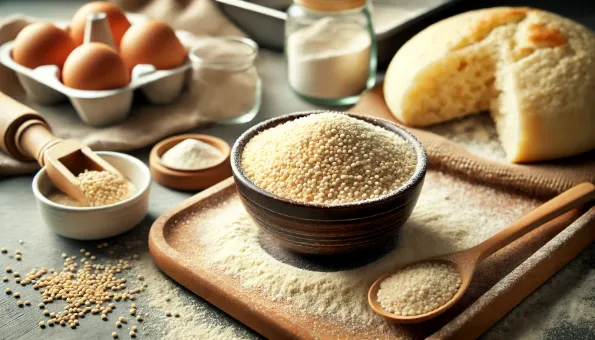Active Dry Yeast: Dormant Saccharomyces Cells That Leaven Dough via CO₂ & Flavor-Producing Fermentation
Granular partially dehydrated *Saccharomyces cerevisiae* that wakes in warm liquid, converting dough sugars/starches to CO₂, ethanol & flavor compounds for rise, structure & aroma.

What Is Active Dry Yeast?
Active dry yeast (ADY) consists of **dormant, living *Saccharomyces cerevisiae* cells** coated in a layer of dry, protective dead cells. When rehydrated in warm water (≈38–43 °C / 100–110 °F) with a small carbohydrate source, cells resume metabolism and reproduce, producing **carbon dioxide & ethanol** that leaven dough and build flavor.
Composition & Nutrition (per 1 tsp • ~3.1 g)
| | Amount | Notes |
|---|---|---|
| Calories | ~10 kcal | Mainly protein/carbs inside cells |
| **Protein** | ~1.1 g | Yeast cell mass |
| **Carbohydrate** | ~1.5 g | Glycogen, trehalose |
| **Fiber (beta-glucans)** | ~0.5 g | Cell wall polysaccharides |
| **B Vitamins** | Small amounts B1, B2, B3, folate | Not a fortified 'nutritional yeast' |
| Minerals | Trace selenium, zinc, potassium | Minor in baking portion |
Primarily used for **function (leavening & flavor)**, not as a major nutrient source.
Fermentation Science
Yeast secretes **enzymes (invertase, maltase)** to hydrolyze sucrose & maltose; dough amylase releases maltose from starch. Glycolysis → pyruvate → ethanol + CO₂ (anaerobic). Secondary products (organic acids, esters, aldehydes) build **bread aroma & complexity**. Proper fermentation strengthens gluten (time & acidity) and improves digestibility.
Functional Benefits in Baking
- **Leavening gas** (CO₂) creates open crumb & volume.
- **Flavor development**: Fermentation yields subtle sweetness, nutty, malty, and fruity notes vs chemical leaveners.
- **Dough conditioning**: Organic acids & glutathione influence extensibility and crumb tenderness.
- **Shelf-life & texture**: Proper fermentation can improve moisture retention & staling resistance.
Drawbacks & Precautions
- **Temperature sensitivity**: Water >49 °C (120 °F) can kill yeast; too cold slows activation.
- **Salt & sugar osmotic stress**: Very high sugar or salt doughs require adaptation (osmotolerant yeast or adjusted hydration).
- **Overfermentation**: Exhausted yeast → collapse, sour/off flavors.
- **Not suitable for people on strict low-FODMAP elimination** (fermentation byproducts + fructans in wheat; yeast itself usually fine but associated foods may not).
Activation & Usage
Traditional ADY benefits from **proofing**: dissolve in 4–5× its weight of warm water (100–110 °F) with a pinch of sugar; wait 5–10 min for foamy surface before mixing. Some modern ADY granules are finer & can be mixed directly into flour if hydration is adequate (>60%). Common usage: **~1–2% of flour weight** (e.g., 5–10 g per 500 g flour) for standard breads; reduce for long cold ferment (0.1–0.5%).
Technique & Optimization
- **Hydration temperature**: 38–43 °C ideal; use instant-read thermometer.
- **Adjust for dough type**: Enriched/sweet doughs (≥12% sugar) may need more yeast (3–4%) or longer fermentation.
- **Salt timing**: Mix early for even distribution; avoid dumping salt directly on yeast concentrate (osmotic shock).
- **Cold retard** (4 °C overnight) for flavor: reduce yeast % to prevent overproofing.
- **Preferments** (poolish, sponge, biga) expand flavor & strength with smaller yeast quantity.
Active Dry vs Instant vs Fresh
| Feature | Active Dry | Instant (RapidRise) | Fresh (Cake) |
|---|---|---|---|
| Moisture | Low (≈8%) | Lower (≈5%) | High (≈70%) |
| Granule size | Larger | Fine | Putty block |
| Need to proof? | Recommended | No (direct mix) | Crumble into dough |
| Relative power* | Baseline | ~10–15% higher | Similar to ADY (adjust weight) |
| Shelf-life sealed | 1–2 yrs | 1–2 yrs | Short (weeks) |
*Adjust quantities: 1 tsp instant ≈ 1 1/4 tsp ADY; fresh ≈ 3× weight of ADY.
Troubleshooting
- **No foam in proof**: Water too hot/cold, expired yeast, or no available sugar.
- **Slow rise**: Low dough temperature (<24 °C), insufficient yeast %, excessive salt/sugar, tight gluten needs rest.
- **Collapsed loaf**: Overproofed (dough doubled then deflated); reduce final proof time.
- **Yeasty/alcohol smell**: Underbaked or overfermented; adjust timing & bake to correct internal temp (≈93–96 °C for pan loaves).
Storage & Shelf Life
Store **unopened packets cool & dry**. After opening, transfer to airtight container; refrigerate 4–6 months or freeze up to 1 year (use directly from cold). Always test older yeast with a small proof. Keep away from moisture & oxygen to preserve viability.
Health & Dietary Notes
Baking yeast is **inactive after baking temperatures** (most cells die above ~60 °C). Yeast contributes modest B vitamins but baking dilutes them. Suitable for vegan & gluten-free applications (e.g., GF breads) provided other ingredients are GF.
Key Takeaways
✔︎ Reliable biological leavening & flavor agent
✔︎ Optimize temperature, hydration & timing for best rise
✖︎ Heat, salt, sugar extremes or overproofing reduce performance.
- 1. Active Dry Yeast
Used for its leavening properties and flavor

